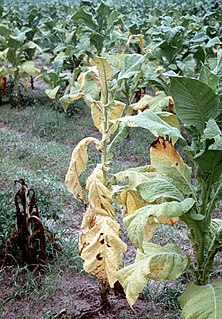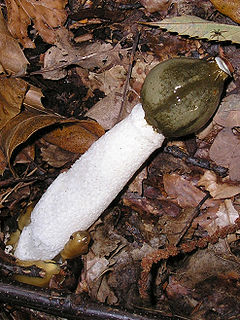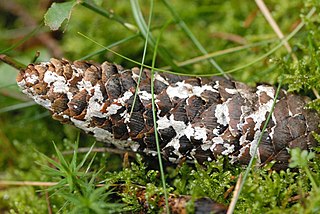
Fusarium wilt is a common vascular wilt fungal disease, exhibiting symptoms similar to Verticillium wilt. This disease has been investigated extensively since the early years of this century. The pathogen that causes Fusarium wilt is Fusarium oxysporum. The species is further divided into forma specialis based on host plant.

Trachycarpus is a genus of eleven species of palms native to Asia, from the Himalaya east to eastern China. They are fan palms, with the leaves with a bare petiole terminating in a rounded fan of numerous leaflets. The leaf bases produce persistent fibres that often give the trunk a characteristic hairy appearance. All species are dioecious, with male and female flowers produced on separate plants although female plants will sometimes produce male flowers, allowing occasional self-pollination.
Cercospora is a genus of ascomycete fungi. Most species have no known sexual stage, and when the sexual stage is identified, it is in the genus Mycosphaerella. Most species of this genus cause plant diseases, and form leaf spots. It is a relatively well-studied genus of fungus, but there are countless species not yet described, and there is still much to learn about the best-known of the species.

Damping off is a horticultural disease or condition, caused by several different pathogens that kill or weaken seeds or seedlings before or after they germinate. It is most prevalent in wet and cool conditions.

The genus Phallus, commonly known as stinkhorns, are a group of basidiomycetes which produce a phallic, often foul-scented, mushroom, from which their name is derived. The genus has a widespread distribution and, according to a 2008 estimate, contains 18 species. They belong to the family Phallaceae in the order Phallales. The best known species is the common stinkhorn.

Ascochyta is a genus of ascomycete fungi, containing several species that are pathogenic to plants, particularly cereal crops. The taxonomy of this genus is still incomplete. The genus was first described in 1830 by Marie-Anne Libert, who regarded the spores as minute asci and the cell contents as spherical spores. Numerous revisions to the members of the genus and its description were made for the next several years. Species that are plant pathogenic on cereals include, A. hordei, A. graminea, A. sorghi, A. tritici. Symptoms are usually elliptical spots that are initially chlorotic and later become a necrotic brown. Management includes fungicide applications and sanitation of diseased plant tissue debris.

Cercospora apii is a fungal plant pathogen, who causes leaf spot on celery, and found on other plants, including Impatiens. Since the genus Cercospora is one of the largest and most heterogeneous genera of hyphomycetes, numerous species described from diverse hosts and locations are morphologically indistinguishable from C. apii and subsequently are referred to as C. apii sensu lato.

The Atheliaceae are a family composed exclusively of corticioid fungi, placed under the monotypic order Atheliales. Both the order and the family were described by Walter Jülich in 1981. According to a 2008 estimate, the family contains 20 genera and approximately 100 species. However, many genera formerly considered to belong in the Atheliaceae have since been moved to other families, including Amylocorticiaceae, Albatrellaceae, and Hygrophoraceae. Despite being a relatively small group with inconspicuous forms, Atheliaceae members show great diversity in life strategies and are widespread in distribution. Additionally, being a group strictly composed of corticioid fungi, they may also provide insights on the evolution of fruiting body forms in basidiomycetes.
Curvatispora is a fungal genus in the class Sordariomycetes. The relationship of this taxon to other taxa within the class is unknown. The genus is monotypic, containing the single species Curvatispora singaporensis, which was discovered growing on a fallen decaying frond of Livistona spinosa in Singapore.
Roussoëlla is a genus of fungi in the family Didymosphaeriaceae. The genus is characterized by two-celled ascospores, unitunicate asci with a small spherical apical ring that stains slightly blue with Melzer's reagent, and stromata with several perithecia.
Unisetosphaeria is a fungal genus in the family Trichosphaeriaceae. This is a monotypic genus, containing the single species Unisetosphaeria penguinoides, found on dead petioles and rhachides of the palms Eleiodoxa conferta and Nenga pumila in Sirindhorn Peat Swamp Forest, southern Thailand.

Annulatascus is a genus of fungi in the Annulatascaceae family of the Ascomycota. The relationship of this taxon to other taxa within the Sordariomycetes class is unknown, and it has not yet been placed with certainty into any order. The genus is characterized by taxa that are saprobic on submerged, decaying plant material in freshwater habitats. Morphologically the taxa possess dark brown to black perithecia, long tapering hyaline septate paraphyses, eight-spored asci with relatively massive J- apical rings, and ascospores that may or may not possess gelatinous sheaths or appendages. There are currently 17 species included in the genus.
Phruensis is a fungal genus in the Valsaceae family. It is monotypic, containing the single species Phruensis brunneispora, found on decaying trunks of the palm Licuala longecalycata in Thailand. The species was described as new to science in 2004.

Clavaria is a genus of fungi in the family Clavariaceae. Species of Clavaria produce basidiocarps that are either cylindrical to club-shaped or branched and coral-like. They are often grouped with similar-looking species from other genera, when they are collectively known as the clavarioid fungi. All Clavaria species are terrestrial and most are believed to be saprotrophic. In Europe, they are typical of old, mossy, unimproved grassland. In North America and elsewhere, they are more commonly found in woodlands.
Betaflexiviridae is a family of viruses in the order Tymovirales. Plants and fungi serve as natural hosts. There are currently 87 species in this family, divided among 7 genera. Diseases associated with this family include: mosaic and ringspot symptoms.

Ceratobasidium is a genus of fungi in the order Cantharellales. Basidiocarps are effused and the genus is sometimes grouped among the corticioid fungi, though species also retain features of the heterobasidiomycetes. Rhizoctonia-like anamorphs of Ceratobasidium species are placed in the genus Ceratorhiza. Species are saprotrophic, but several are also facultative plant pathogens, causing a number of commercially important crop diseases. Some are also endomycorrhizal associates of orchids.

Teratosphaeriaceae is a family of fungi in the order Capnodiales.
Escovopsis is a genus of seven formally acknowledged parasitic microfungus species that rely on other fungi to be their hosts. This genus formally circumscribed with a single identified species in 1990; in 2013 three other species were added.
Escovopsis aspergilloides is a species of fungus that was rediscovered in 1995 by mycologists Keith A. Seifert, Robert A. Samson and Ignacio Chapela. Escovopsis aspergilloides co-exist in a symbiotic relationship with attini ants - fungus-growing ants. The highly evolved, ancient ant-fungus mutualism has become a model system in the study of symbiosis. In spite of this, the genus Escovopsis was not proposed until 1990 and the first two species were not formally described until the 1990s: E. weberi by Muchovej and Della Lucia in 1990 E. aspergilloides by Seifert, Samson and Chapela in 1995.












